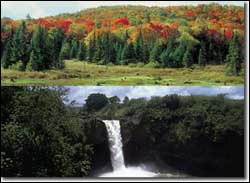New simulations of 21st-century climate show that human-produced changes in land cover could produce additional warming in the Amazon region comparable to that caused by greenhouse gases, while counteracting greenhouse warming by 25% to 50% in some midlatitude areas. The simulations from the National Center for Atmospheric Research (NCAR) show the importance of including land cover in computer-model depictions of global change. The results will be published in the December 9 issue of Science.
If humans continue to use fossil fuels in a business as usual manner for the next several centuries, the polar ice caps will be depleted, ocean sea levels will rise by seven meters and median air temperatures will soar 14.5 degrees warmer than current day.
These are the stunning results of climate and carbon cycle model simulations conducted by scientists at the Lawrence Livermore National Laboratory. By using a coupled climate and carbon cycle model to look at global climate and carbon
Surveys of three streams in the Russian River watershed show the first encouraging signs that a ground-breaking recovery effort is making headway rescuing coho salmon from the brink of extinction in part of its historic California range.
Recently completed snorkeling and electrofishing surveys estimate survival of more than 12,000 young fingerlings released last spring into Palmer, Sheephouse and Gray creeks at 54, 60 and 71 percent, respectively.
“We’re thrilled to see

Planting trees across the United States and Europe to absorb some of the carbon dioxide emitted by the burning of fossil fuels may just outweigh the positive effects of sequestering that CO².
New climate modeling research from LLNL and the Carnegie Institution shows that northern temperate forests (top) may contribute to global warming, while tropical forests (bottom) can help keep global temperatures cool. (Click here to download a high-resolution image.)
In theory, gro
Growing a forest might sound like a good idea to combat global warming, since trees draw carbon dioxide from the air and release cool water from their leaves. But they also absorb sunlight, warming the air in the process. According to a new study from the Carnegie Institution’s Department of Global Ecology and Lawrence Livermore National Laboratory, planting forests at certain latitudes could make the Earth warmer. Carnegie’s Ken Caldeira will present the work at the American Geophysical Union Fal

Glacier has shrunk by nine miles, now at midpoint of retreat
Alaska’s rapidly disintegrating Columbia Glacier, which has shrunk in length by 9 miles since 1980, has reached the mid-point of its projected retreat, according to a new University of Colorado at Boulder study.
Tad Pfeffer, associate director of CU-Boulder’s Institute of Arctic and Alpine Research, said the glacier is now discharging nearly 2 cubic miles of ice annually into the Prince William Sound,